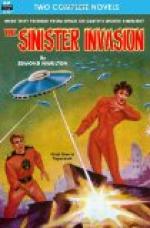“Why, a searchlight beam is stopped by a cloud, which is many mist-droplets in one place. It’s scattered until it simply doesn’t penetrate!” Lockley suddenly seemed indignant at his own failure to see something that had been so obvious all along. “If we could make a cloud of ions, it should stop the terror beam as clouds stop light! We could—”
Again he stopped short, and Jill’s expression changed. She looked confident again. She even looked proud as she watched Lockley wrestling with his problem, unconsciously snapping his fingers.
“Vale and I,” he said jerkily, “had electronic base-measuring instruments. Some of their elements had to be buried in plastic because otherwise they ionized the air and leaked current like a short. If I had that instrument now—No. I’d have to take the plastic away and it couldn’t be done without smashing things.”
“What would happen,” asked Jill, “if you made what you’re thinking about?”
“I might,” said Lockley. “I just possibly might make a gadget that would create a cloud of ions around the person who carried it. And it might reflect some of the terror beam and refract the rest so none got through to the man!”
Jill said hopefully, “Then tonight we go into a deserted town and steal the things you need....”
Lockley interrupted in a relieved voice, “No-o-o-o. What I need, I think, is a cheese grater and the pocket radio. And there should be a cheese grater in the house.”
He listened at the barn door gap, and then went out. Presently he was back. He had not only a cheese grater but also a nutmeg grater. Both were made of thin sheet metal in which many tiny holes had been punched, so that sharp bits of torn metal stood out to make the grating surface. Lockley knew that sharp points, when charged electrically, make tiny jets of ionized air which will deflect a candle flame. Here there were thousands of such points.
He set to work on the car seat, pushing the pistol with its three remaining bullets out of the way. The pistol was reserved for Jill in case of untoward events, when it would be of little or no practical value.
He operated on the tiny radio with his pocket-knife to establish a circuit which should oscillate when the battery was turned on. There was induction, to raise the voltage at the peaks and troughs of the oscillations. A transistor acted as a valve to make the oscillations repeated surges of current of one sign in the innumerable sharp points of the graters. And there was an effect he did not anticipate. The ion-forming points were of minutely different lengths and patterns, so the radiation inevitably accompanying the ion clouds was of minutely varying wave lengths. The consequence of using the two graters was, of course, that rather astonishing peaks of energy manifested themselves in ultra-microscopic packages for a considerable distance from the device. But Lockley did not plan that. It happened because of the materials he had to use in lieu of something better.




